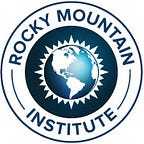Finding the Comfort Zone
RMI’s under-construction Innovation Center in Basalt, CO, pushes the boundaries of thermal comfort — condition the person, not just the space
Some 30 years ago, Rocky Mountain Institute cofounder and chief scientist Amory Lovins was relaxing in a home in Japan one winter’s day when he realized it wasn’t heated. “Why don’t you heat your house?” he asked his hostess. “Why should I?” she replied. “Is the house cold?”
Her response embodies a perspective that seems obvious but is seldom practiced: condition the person, not the space. It’s inefficient to heat or cool the whole space when we occupy only a tiny fraction of it.
Today, that principle and the underlying notion of thermal comfort are key to achieving net-zero energy consumption at RMI’s Innovation Center, a 15,610-square-foot office building under construction in Basalt, Colorado. When completed in late 2015, the building will include a convening hall, office space for 50 staff, and support space.
By designing around the question “are you comfortable?” instead of “what’s the temperature?”, RMI and partners are creating a model office building that will use a fraction of the energy typical for a building this size. It’ll combine passive solar heating, passive cooling, daylighting, operable shading, natural ventilation, a super-airtight and heavily insulated building envelope, and onsite electric-vehicle charging stations. Thermal comfort techniques top off the energy savings, enabling RMI to achieve breakthrough energy efficiencies.
Cara Carmichael, a manager in RMI’s buildings practice, coordinates the design and construction team that includes design architect ZGF Architects, general contractor JE Dunn, John Breshears of the firm a2 for high-performance design consultation, and Graybeal Architects as local architect.
Not Too Hot, Not Too Cold
The idea of maintaining thermal comfort usually comes down to setting a thermostat to keep the air within a certain temperature range. But conditioning a person to feel comfortable involves at least six variables: air temperature, air speed, humidity, clothing level, activity level, and the temperature of surfaces such as walls, windows, desks, tables, and seats. As it turns out, conditioning people to feel comfortable through these variables proves far more efficient than conditioning the space those people occupy.
For the Innovation Center, the RMI design team managed all six variables while still meeting “the comfort standards of most people — 90 percent — within a greatly expanded air temperature range,” says Chris McClurg, a senior associate in RMI’s buildings practice. Call it the Goldilocks zone, neither too hot nor too cold.
Conditioning people to feel comfortable proves far more efficient than conditioning the space those people occupy.
Large south-facing windows enable direct solar gain, which heats thermal mass in the floors in the winter and re-radiates heat to occupants so they feel warm even if the air is slightly cool. In the summer, carefully placed operable windows draw in chilly night air that cools off the thermal mass, pleasantly tempering the next day’s higher temperatures.
More prosaically, RMI encourages everyone, from staff to visitors, to dress appropriately, such as wearing a sweater in winter and short sleeves in summer. Natural ventilation, efficient ceiling fans, and personal USB-powered fans regulate airspeed, another important factor in warm weather. Accessories like radiant underfoot pads or heated mouse pads also help in the coldest weather.
The Hyperchair
Staff will also enjoy one piece of brand-new technology: the Hyperchair. Developed by the University of California, Berkeley’s Center for the Built Environment and RMI senior fellow Peter Rumsey, this normal-looking office chair works like a heated and ventilated car seat. Users adjust built-in fans and heating elements to their taste. A rechargeable laptop battery runs the chair.
Combining these people-focused options widened the air temperature range in which people in the building would feel comfortable from the typical 68–72 degrees Fahrenheit to 62–84 degrees, McClurg says.
The payoff was huge. “We were able to eliminate our cooling system entirely,” says Carmichael. “We minimized our heating system such that it only takes the equivalent of 13 hair dryers to heat the entire building.” The only mechanical equipment will be a heat exchanger between outgoing stale air and incoming fresh air.
The Innovation Center has a design energy use intensity of 18 kBTU per square foot per year, she says, just one-fourth the typical small office building’s score of around 70 kBTU. An 80-kW grid-tied solar array will power the Innovation Center’s remaining anemic energy needs.
RMI planned the Innovation Center as a practical, replicable model. Since 90 percent of commercial buildings are less than 25,000 square feet, most of those are offices, and three-fourths are likely to be retrofitted by 2035, the path blazed by the Innovation Center can lead to vast energy savings. Says Carmichael: “Thermal comfort and the passive approach can be applied to any building.”
Written by Charles C. Poling, a New Mexico-based freelance writer whose architecture writing has appeared in Dwell, New Mexico Magazine, and others. He wrote about Houston’s HOUZE in the Summer 2014 issue of Solutions Journal.
Web Extra
For more information on this topic visit: rmi.org/rmi_innovation_center
